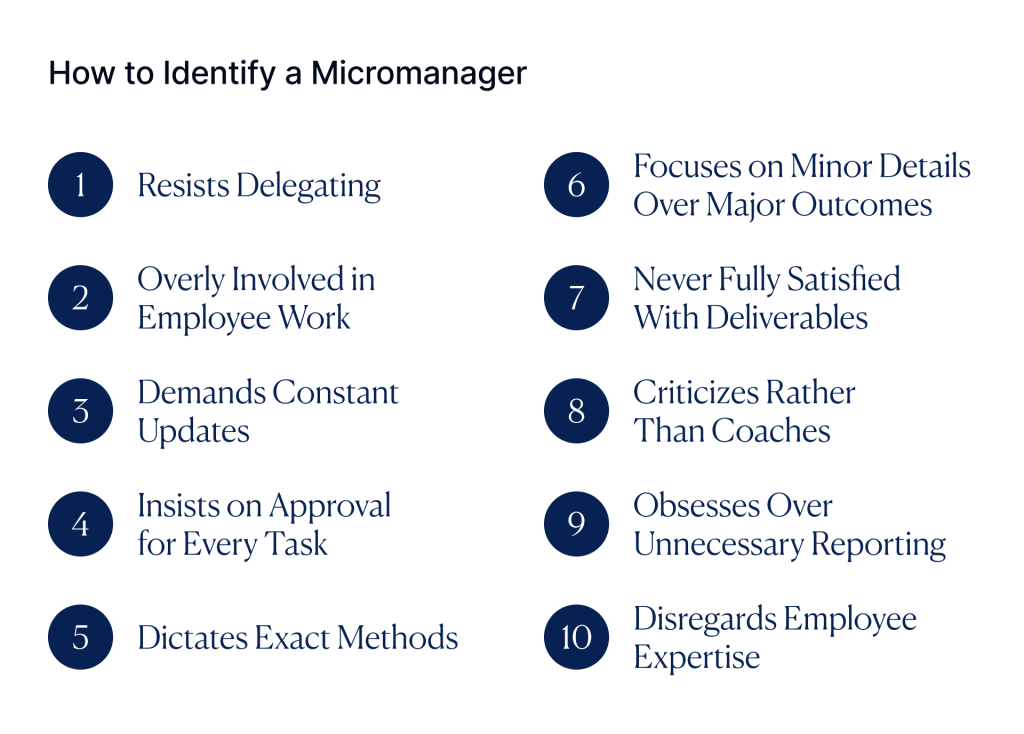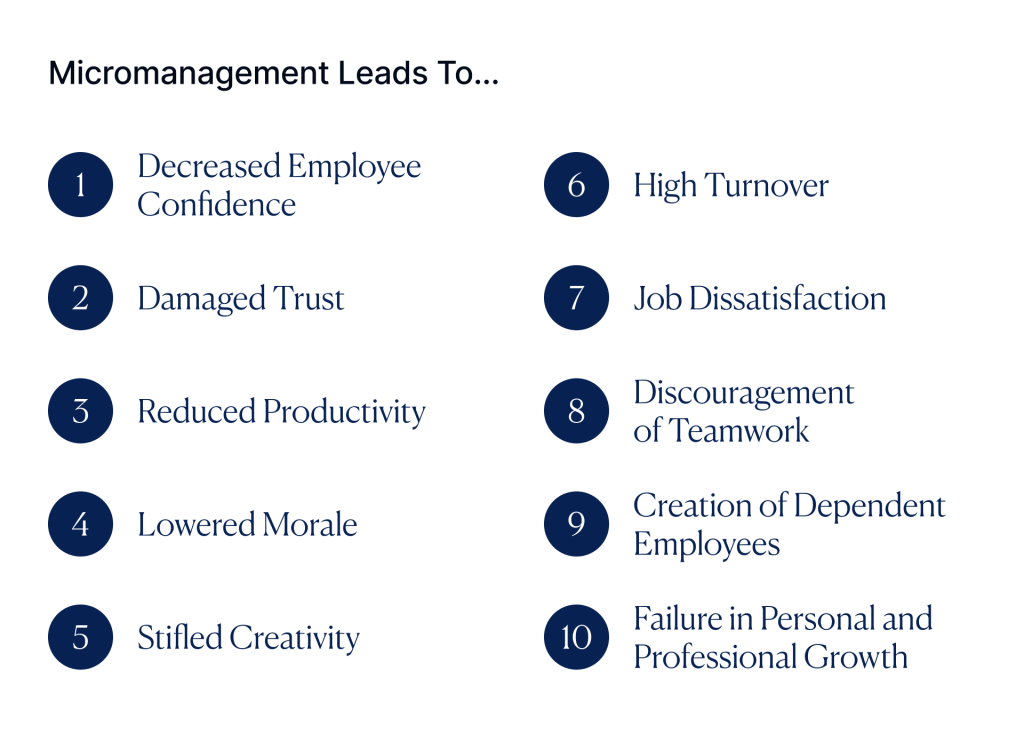
Many managers fall into the habit of micromanaging with the intention to maintain control and ensure precision in their business operations. But doing so has long been a contentious topic in leadership circles.
While some managers and executives argue that micromanagement helps them to maintain quality standards and minimize errors, others argue that its drawbacks far outweigh any perceived benefits.
Micromanagement, characterized by excessive scrutiny and intervention in even the minutest of tasks, can ultimately undermine team morale, stifle creativity, and impede organizational growth.
An Example of Micromanagement in Action
If you’ve never seen the effects micromanagement can have, I’d like to share a short, fictionalized example—one involving a marketing executive and a social media manager.
The marketing executive in question oversees the marketing department of a large company—it’s a stressful job, and they often feel anxious because of it. They assign a project to the social media manager, who has been a social media professional for more than a decade and was hired for their out-of-the-box and creative approach to social media marketing.
The marketing executive asks the social media manager to develop a new campaign to boost online engagement. They need to show the rest of the C-suite that the company’s marketing initiatives are paying off by growing the company’s online community.
The social media manager begins the project with enthusiasm. They are excited to have been trusted with this project and they are even more excited to prove their worth to the C-suite. They start outlining a courageous strategy that uses the latest trends and technologies to create online engagement.
But soon after the project starts, the marketing executive begins checking in multiple times a day. They demand to review every minor detail—from the specific wording of posts to the exact colors used in images—and they insist on approving every aspect before the social media manager can proceed.
Each time the social media manager presents an idea, the marketing executive makes numerous changes or rejects their attempts at innovation. The marketing executive often reverts back to more traditional approaches that they are comfortable with and learned at university 20 years ago, despite the social media manager’s expertise suggesting otherwise. The marketing executive’s constant oversight restricts the social media manager’s ability to experiment and iterate. In the end, it severely hampers the social media manager’s creative process.
Over time, the social media manager’s initially high morale and enthusiasm begin to wane. They feel stifled and undervalued; and they sense that the marketing executive lacks trust in their skills and judgment.
The campaign the social media manager eventually produces is technically proficient but lacks the creative spark of their past work. The lack of autonomy and creative freedom under the marketing executive’s micromanagement has not only dulled the campaign’s impact but also diminished the social media manager’s engagement and satisfaction with their job.

The Effects of Micromanagement
The effects of micromanagement are never good; that is to say—micromanagement is never an appropriate leadership or management style. I’ll repeat that for the people in the back: it is never a good thing to micromanage your workforce—yes, no matter what.
Micromanagement absolutely kills creativity and innovation within an organization and across teams. When employees are constantly being told exactly how to do their jobs (and then monitored like prisoners to ensure they don’t deviate), they have little opportunity to think outside the box or propose new ideas. This can result in a stagnant work environment where innovation is stifled, and the organization fails to adapt to changing market conditions. It can also lead to (and almost always will lead to) employee disengagement and high employee turnover.
However, tackling a problem like micromanagement head-on and solving it can help your business come on in leaps and bounds (and your employees will thank you for it). Leaders who empower their employees to take ownership of their work and make decisions autonomously foster a culture of innovation and creativity. When leaders trust their team members to use their judgment and expertise, they create an environment where employees feel valued and are motivated to perform at their best. This not only leads to higher levels of employee satisfaction but also results in better business outcomes.

Why Do Leaders Micromanage?
After reading the story about the marketing executive and the social media manager, you might be wondering why the marketing executive would resort to micromanagement at all when it’s clear that the social media manager is capable and that the marketing executive has made their end product worse by micromanaging them. The reasons for micromanagement are complex and boil down to human psychology.
The answer, according to research published by the Association for Psychological Science, is that leaders resort to micromanagement when they feel powerless. The same research showed that the more empowered and powerful a leader feels, the more likely they are to share their power and delegate responsibilities.
That means leaders who micromanage are facing one of two problems: first, they may actually be powerless (either because they’re being micromanaged themselves or due to other factors impacting their control over their workforce); second, they may feel powerless without actually being powerless—and this is usually a result of low self-esteem and self-confidence. In both of these cases, a micromanager can benefit greatly from leadership development and executive coaching.

How to Avoid Micromanagement
Knowing that micromanagement is not an effective management or leadership style is a step in the right direction, but this knowledge alone won’t necessarily help you to avoid (or stop being) a micromanager. To do that, you need to take a few extra steps.
The first step is effective delegation, which is the answer to avoiding the pitfalls of micromanagement. Leaders should learn to trust their team members to take on responsibility and make decisions without constant oversight. When leaders achieve this and do it correctly, it not only lightens the leader’s workload but also empowers employees to develop their skills and grow professionally.
By delegating effectively, leaders can focus their time and energy on what their role actually involves—strategic initiatives that drive the organization forward, as opposed to the day-to-day tasks that micromanagers inevitably end up obsessing over.
To avoid being (or becoming) micromanagers, leaders should also prioritize open communication and collaboration within their teams. By creating a culture of transparency and trust, leaders can foster an environment where employees feel comfortable sharing their ideas and concerns. This not only leads to better decision-making but also strengthens relationships within the team.
Time management plays an important role in avoiding micromanagement too. Leaders should learn to prioritize their tasks and delegate effectively to avoid getting bogged down in minutiae. When leaders focus on high-level strategic goals and empower their team members to handle day-to-day operations, they ensure that their time is spent on activities that really matter.

Great Leaders Aren’t Born—They’re Made
While micromanagement may seem like a means of maintaining control and ensuring precision in business operations, its drawbacks far outweigh any perceived benefits. Leaders who are micromanagers risk undermining employee morale, stifling creativity, and impeding organizational growth.
But great leaders aren’t born; they’re made—just like great leadership styles aren’t inherited; they’re taught. Leaders who struggle with letting go, trusting their team, and avoiding micromanagement aren’t necessarily bad leaders—they are leaders in need of learning better coping mechanisms and leadership skills.

At Stanton Chase, we’ve been helping leaders become the best versions of themselves for over 30 years. Click here to reach out to one of our consultants to discuss how we can help you or your executives become the best versions of themselves through leadership assessment, leadership development, or executive coaching.
About the Author
As a Partner at Stanton Chase Istanbul, Can Arcasoy brings a wealth of experience in consumer goods, brand marketing, strategy, and general management. He is particularly passionate about working closely with leadership teams in organizations to help them navigate uncertain and volatile competitive environments.
Can has repeatedly demonstrated his ability to implement new organizational structures, which have been key to achieving positive results. He is known for his expertise in managing effective cross-functional, multidisciplinary teams, setting up agile organizations, and introducing data-informed decision-making processes and capability-building.
He enjoys giving lectures and serving as a keynote speaker at various business schools and associations. He is particularly active in sharing his global experience with startups.
How Can We Help?
At Stanton Chase, we're more than just an executive search and leadership consulting firm. We're your partner in leadership.
Our approach is different. We believe in customized and personal executive search, executive assessment, board services, succession planning, and leadership onboarding support.
We believe in your potential to achieve greatness and we'll do everything we can to help you get there.
View All Services